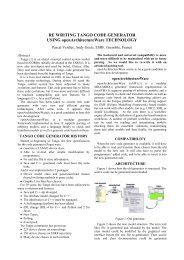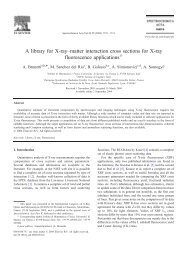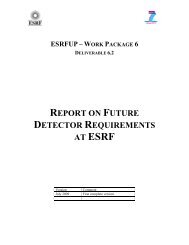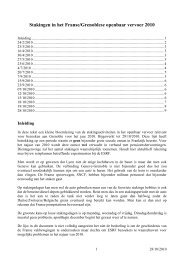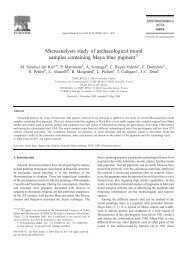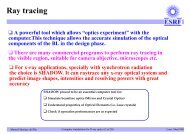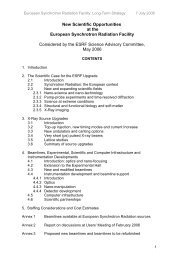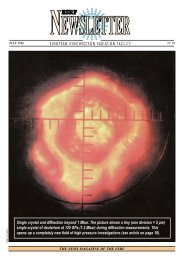A method for detailed simulations of neutron diffraction from ... - ESRF
A method for detailed simulations of neutron diffraction from ... - ESRF
A method for detailed simulations of neutron diffraction from ... - ESRF
Create successful ePaper yourself
Turn your PDF publications into a flip-book with our unique Google optimized e-Paper software.
232<br />
or transmission geometry are included. We<br />
carry out a benchmarking <strong>of</strong>the component by<br />
comparison with the Monochromator-curved<br />
component.<br />
2. Computation <strong>method</strong> and examples<br />
Monochromator-curved is a ray-tracing module,<br />
i.e. a code in which the Monte Carlo <strong>method</strong> is<br />
used to choose the fate <strong>of</strong> a ray impinging on the<br />
crystal. The crystal has no thickness, hence the<br />
beam penetration and secondary extinction are not<br />
simulated. There are two input parameters required<br />
<strong>for</strong> describing the crystal reflectivity: peak<br />
reflectivity R0 and mosaicity mosaic. These are<br />
used to build a probability distribution <strong>of</strong>the<br />
reflected rays versus the grazing angle. In Monochromator-curved,<br />
the input parameter mosaic is<br />
the full-width at half-maximum (FWHM) <strong>of</strong> the<br />
reflectivity pr<strong>of</strong>ile. The same parameter mosaic is<br />
used <strong>for</strong> sampling the additional divergence <strong>of</strong> the<br />
outgoing beam. Hence, in the original Monochromator-curved<br />
code, there is not a clear distinction<br />
<strong>of</strong> the difference between the two different<br />
concepts <strong>of</strong>mosaicity and FWHM <strong>of</strong>the reflectivity<br />
pr<strong>of</strong>ile. In the new component, we use a<br />
more suitable definition <strong>of</strong>mosaicity: Z is the<br />
intrinsic mosaicity, i.e. the FWHM <strong>of</strong>the angular<br />
ARTICLE IN PRESS<br />
L. Alianelli et al. / Nuclear Instruments and Methods in Physics Research A 529 (2004) 231–233<br />
Fig. 1. Divergence pr<strong>of</strong>iles after reflection by a mosaic crystal<br />
Cu 220 with yBragg ¼ 37:5 ; Z ¼ 10 0 B0:17 ; simulated with<br />
Monochromator-reflect (solid lines) and Monochromatorcurved<br />
(dotted and dashed lines). The incident beam is highly<br />
collimated and non monochromatic. TOP: Monochromatorreflect<br />
gives a vertical divergence distribution with FWHM<br />
equal to 0:20 ¼ 2Z sin y: The pr<strong>of</strong>ile calculated with Monochromator-curved<br />
has FWHM <strong>of</strong>0:33 : This result is due to the<br />
ambiguous definition <strong>of</strong>mosaicity in Monochromator-curved,<br />
i.e. FWHM <strong>of</strong>the reflectivity curve, rather than intrinsic<br />
mosaicity. The dashed curve, obtained by using mosaic ¼ Z as<br />
input parameter <strong>for</strong> Monochromator-curved, provides the<br />
correct outgoing vertical divergence. BOTTOM: the FWHMs<br />
<strong>of</strong>the horizontal divergence distributions agree well, except that<br />
the Monochromator-curved simulated data have a Gaussian<br />
shape (the fit is not shown), which in general does not<br />
correspond to reality. The horizontal resolution, in fact, is<br />
determined by the shape <strong>of</strong>reflectivity. The use <strong>of</strong>mosaic ¼ Z<br />
with Monochromator-curved (dashed line) gives a smaller<br />
divergence.<br />
distribution <strong>of</strong>the small perfect crystallites in the<br />
mosaic crystal. The theory [4] shows that the<br />
FWHM and peak value <strong>of</strong>the reflectivity pr<strong>of</strong>ile<br />
are functions <strong>of</strong> the crystal intrinsic mosaicity Z;<br />
but depend also on other parameters, like thickness,<br />
scattering and attenuation factors. It is<br />
important, there<strong>for</strong>e, when simulating a mosaic<br />
crystal, to use weight distributions (or reflectivities)<br />
that have the correct dependence on energy<br />
and angle. This is not possible when using<br />
Monochromator-curved. Concerning the angular<br />
Intensity [a.u.]<br />
Intensity [a.u.]<br />
2.5 10 -6<br />
2.0 10 -6<br />
1.5 10 -6<br />
1.0 10 -6<br />
5.0 10 -7<br />
1.5 10 -6<br />
1.0 10 -6<br />
5.0 10 -7<br />
Monochromator_reflect<br />
Monochromator_curved, mosaic = 0.27 deg<br />
Monochromator_curved, mosaic = 0.17 deg<br />
0<br />
-1.0 -0.5 0.0 0.5 1.0<br />
Vertical divergence [deg]<br />
Monochromator_reflect<br />
Monochromator_curved, mosaic = 0.27 deg<br />
Monochromator_curved, mosaic = 0.17 deg<br />
0<br />
-1.0 -0.5 0.0 0.5 1.0<br />
Horizontal divergence [deg]



